
Home - Search - Browse - Alphabetic Index: 0- 1- 2- 3- 4- 5- 6- 7- 8- 9
A- B- C- D- E- F- G- H- I- J- K- L- M- N- O- P- Q- R- S- T- U- V- W- X- Y- Z
RSA
 RSA-1 , -2, -3, -4 |
Status: Retired 1990.
Two shorter-range missiles (the RSA-1 and RSA-2) were intended for use on Cuban or Warsaw Pact troop concentrations should a massed attack be made from an adjacent country. The RSA-4 ICBM was also in long-term development, possibly to deter the United States or Soviet Union from sponsoring such an attack in the first place.
The original intended payload for the missiles was said to be the uranium gun-type atomic bombs developed in South Africa between 1971 and 1989. Seven of these weapons were built, each with a mass of about one metric ton, a diameter of 65 centimeters and a length of 1.8 meters. Each device contained 55 kilograms of highly enriched uranium, producing a fission yield of 10-18 kilotons. Five of the weapons were configured as air-launched bombs, but were said to be adaptable to missile launch. It was planned during the 1990's to lighten and modernize these warheads, and use tritium-boosting to increase the yield to 100 Kt. A missile using the original devices would have to be provided with a heat shield, implying a total warhead mass of around 1500 kg. This would not have permitted the RSA-4 to reach intercontinental range. Presumably the boosted, modernized warheads, that were to have been completed by 2000, would have been under 700 kg and allowed the missile to reach New York or Moscow.
Substantial facilities for assembly, test, and launch of the rockets were built at the Overberg Test Range at the tip of Africa. Overberg was also used for Israeli Jericho-2 test flights.
As a cover for and supplement to the missile development, the R5b indigenous space program was funded. This would use the RSA-3 and RSA-4 launchers. Four South African space rockets were built. Three were launched into suborbital trajectories in the late 1980's in support of development of the RSA-3 launched Greensat Orbital Management System (for commercial satellite applications of vehicle tracking and regional planning). The range was also used for aerospace and system testing for British, Swedish and Czech programs.
Following the decision in 1989 to cancel the nuclear weapons program, the missile programs were allowed to continue until 1992, when military funding ended and South Africa officially ended its missile collaboration with Israel. All ballistic missile work was stopped by mid-1993. In order to join the Missile Technology Control Regime the government had to allow American supervision of the destruction of key facilities applicable to both the long range missile and the space launch programs. The RSA-3 and RSA-4 space launchers were therefore cancelled in 1994.
Prime Contractor Houwteq had to dismantle its existing RSA rocket components, and retrieve and sequester technical data from its subcontractors. Propellant manufacturer Somchem eliminated the RSA solid propellants and rocket casings that remained in stock. Denel filled in its large engine casting pits at Somerset West and demolished its large-scale X-ray inspection equipment. The Hangklip static motor test facility at Rooi Els was converted to a nature reserve. The Overberg Test Range was allowed to remain for use by 'potential foreign partners'. Following these measures, South Africa joined the Missile Technology Control Regime in September 1995.
Houwteq's staff at Overberg grew to a peak of 500 in 1992, before the cancellations began. By 1997 the staff was reduced to 28. Houwteq's Ian Farr continued to market the Overberg facility for commercial launchers until at least 1997. Nothing came of these efforts, and it seems that the book was closed on further indigenous African space activities.
Since much remains undisclosed about the Israeli Jericho missiles and Shavit - Next space launchers, the material on the South African rockets provides some insights into Israeli programs. The RSA-2 clearly corresponds closely to the Jericho-2, and the RSA-3 to the Shavit launcher. It is interesting that there has been no mention of an Israeli counterpart to the Peacekeeper-class first stage motor of the RSA-4. This may represent a 'reserve' Israeli capability to upgrade the Jericho-2 to ICBM range that has never been made public. However there have been reports of Israeli development of a MIRV capability for its missiles. The post-boost warhead dispenser for such a capability could correspond to the RSA-4 fourth stage.
| RSA-1 It is conjectured that this designation was assigned to an intermediate range single-stage ballistic missile consisting of the first stage of the RSA-3. Purported mission was to strike Cuban military concentrations from mobile launchers on South African territory. The rocket motor closely followed the design of the Israeli Jericho-2 first stage. |
| RSA-2 South African intermediate range ballistic missile. It is conjectured that this designation was assigned to an intermediate range ballistic missile consisting of the first and second stages of the RSA-3. Probably very similar to, or a licensed copy of the Israeli Jericho-2 missile. A third stage apogee kick motor was added to produce the RSA-3 space launcher. |
| RSA-4 South African all-solid orbital launch vehicle. The RSA-4 ICBM / satellite launcher was a planned follow-on to the RSA-3. A large new first stage optimized the vehicle and more than doubled the payload in comparison to the RSA-3. It is not known if the project reached the point of testing of the large motor, which was equivalent to the US Peacekeeper first stage. |
Family: orbital launch vehicle. Country: South Africa. Spacecraft: Greensat. Agency: IAI. Bibliography: 2, 240, 241, 466, 467, 468, 469.
 | RSA-3 Aft View Rear view of the RSA-3, showing the exhaust vanes and details of its erector-launcher. Credit: Steven McQuillan |
 | RSA-3 Cutaway Cutaway diagram of RSA-3 space launcher. This differs somewhat from the flight hardware now displayed in South African air museums. Credit: © Mark Wade |
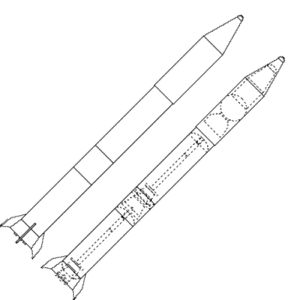 | RSA-3 Credit: © Mark Wade |
 | RSA-3 Aft View Aft view of the RSA-3 showing the jet vanes that provided first stage directional control. Credit: Steven McQuillan |
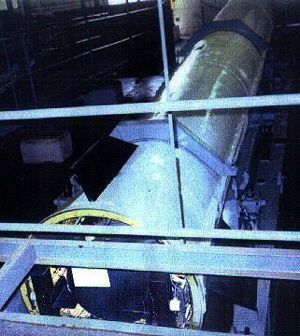 | RSA-3 Aft View Aft view of the RSA-3. Note the small first stage fins. |
 | RSA-3 Interstage Close-up of the RSA-3 interstage section. Credit: Steven McQuillan |
 | RSA-3 Interstage View of RSA-3 forward interstage and payload sections. |
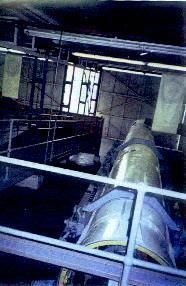 | RSA-3 in Pretoria RSA-3 satellite launcher / long range missile at the A.F. Museum, Pretoria. |
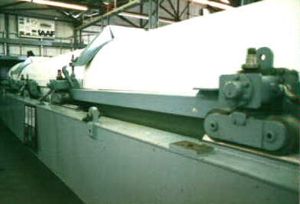 | RSA-3 TEL Detail of the RSA-3 transporter-erector-launcher. Credit: Steven McQuillan |
 | RSA-3 AKM Close-up showing the spherical Apogee Kick Motor third stage of the RSA-3. Credit: Steven McQuillan |
 | RSA-3 Forward View Forward view of the RSA-3 at the Air Force Museum, Pretoria. Credit: Steven McQuillan |
 | RSA-3 Forward View Forward section of the RSA-3; cut-outs reveal the Apogee Kick Motor third stage and the satellite within the payload shroud. Credit: Steven McQuillan |
 | RSA-3 Engine Test Technicians prepare RSA-3 stage in the test stand. |
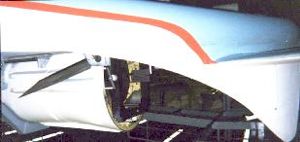 | RSA-3 - base detail RSA-3 - detail of rocket base, side view |
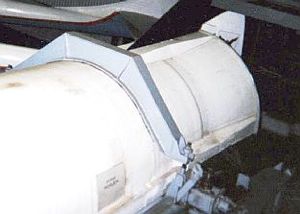 | RSA-3 - stage detail RSA-3 - close-up of rocket in transporter |
 | RSA-3 - stage detail RSA-3 - detail of first stage base and rocket nozzle |
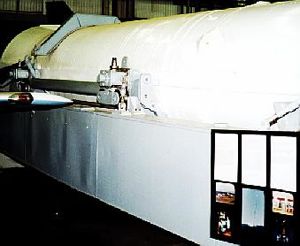 | RSA-3 - stage detail RSA-3 - close-up of rocket in transporter |
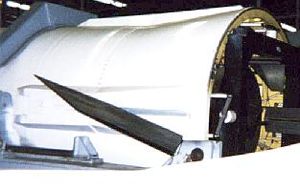 | RSA-3 - base detail RSA-3 - detail of rocket base, side view |
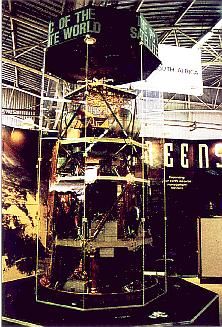 | RSA-3 - payload RSA-3 - satellite payload and kick stage |
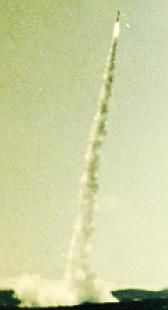 | RSA-3 - launch photo |
 | RSA-3 - nose detail RSA-3 - detail of nose cone |
 | Title Page Introduction to the RSA-4 Launch Vehicle Credit: Denel / Houwteq |
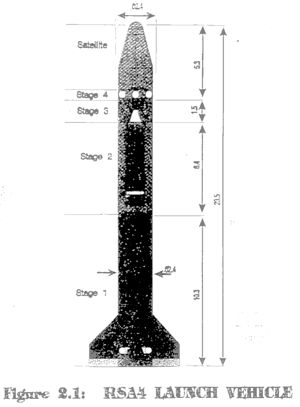 | Figure 2.1 RSA-4 Launch Vehicle Credit: Denel / Houwteq |
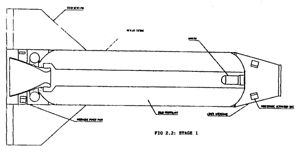 | Figure 2.2 Stage 1 Credit: Denel / Houwteq |
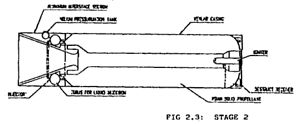 | Figure 2.3 Stage 2 Credit: Denel / Houwteq |
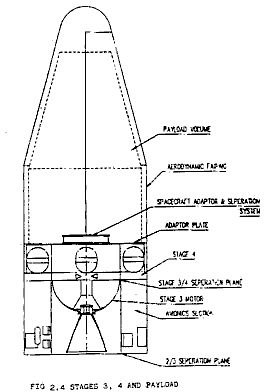 | Figure 2.4 Stages 3, 4 and Payload Credit: Denel / Houwteq |
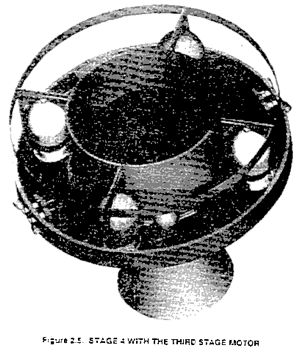 | Figure 2.5 Stage 4 with Third Stage Motor Credit: Denel / Houwteq |
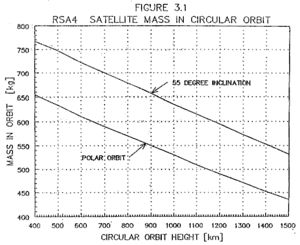 | Figure 3.1 RSA 4 Satellite Mass in Circular Orbit Credit: Denel / Houwteq |
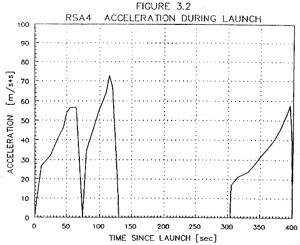 | Figure 3.2 RSA 4 Acceleration During Launch Credit: Denel / Houwteq |
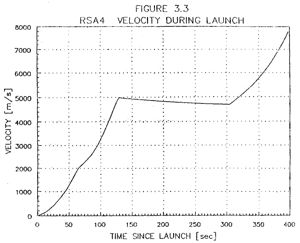 | Figure 3.3 RSA 4 Velocity During Launch Credit: Denel / Houwteq |
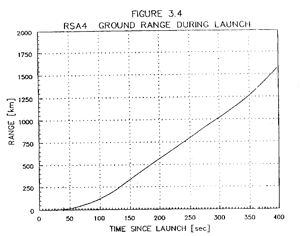 | Figure 3.4 RSA 4 Ground Range During Launch Credit: Denel / Houwteq |
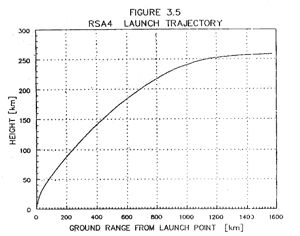 | Figure 3.5 RSA 4 Launch Trajectory Credit: Denel / Houwteq |
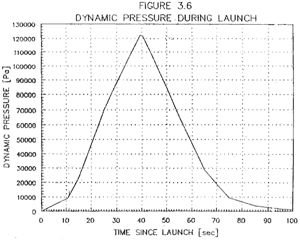 | Figure 3.6 Dynamic Pressure During Launch Credit: Denel / Houwteq |
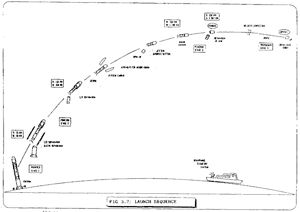 | Figure 3.7 Launch Sequence Credit: Denel / Houwteq |
 | Figure 3.8 Stage 4 / Satellite Separation in 1400 km Orbit Credit: Denel / Houwteq |
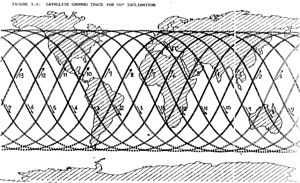 | Figure 3.9 Satellite Ground Track for 65 deg Inclination Credit: Denel / Houwteq |
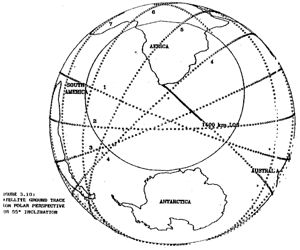 | Figure 3.10 Satellite Ground Track from Polar Perspective for 55 deg Inclination Credit: Denel / Houwteq |
 | Figure 3.11 Ground Station Coverage for Delta-V Burn to Circularise Orbit at 1400 km Credit: Denel / Houwteq |
1994 June - . LV Family: Jericho. Launch Vehicle: RSA.
- RSA-3 / RSA-4 South African satellite launchers cancelled - .
Nation: South Africa.
The RSA-3 satellite launcher began development as an IRBM in the 1980's. It was developed with the assistance of Israel. The satellite launcher was found not to be viable commercially and so was cancelled in mid-1994. The Overberg Test Range near Bredasdorp, 200 km east of Cape Town, was used for test flights.
Back to top of page
Home - Search - Browse - Alphabetic Index: 0- 1- 2- 3- 4- 5- 6- 7- 8- 9
A- B- C- D- E- F- G- H- I- J- K- L- M- N- O- P- Q- R- S- T- U- V- W- X- Y- Z
© 1997-2019 Mark Wade - Contact
© / Conditions for Use

